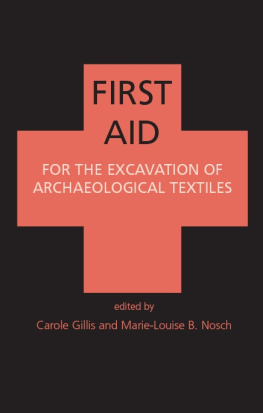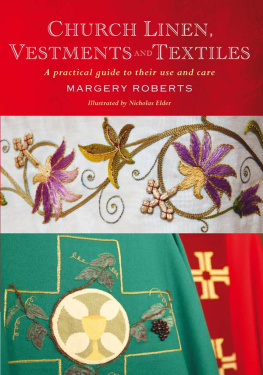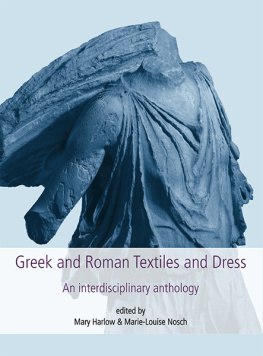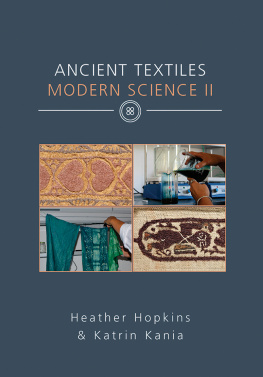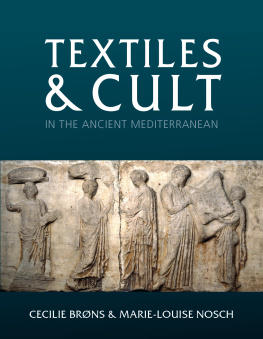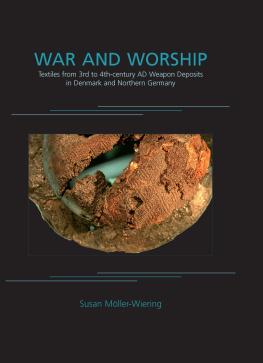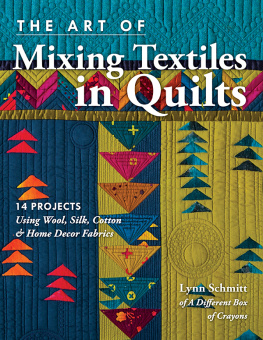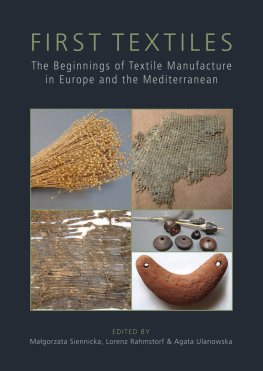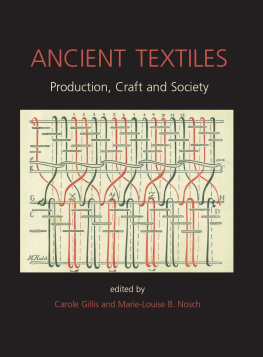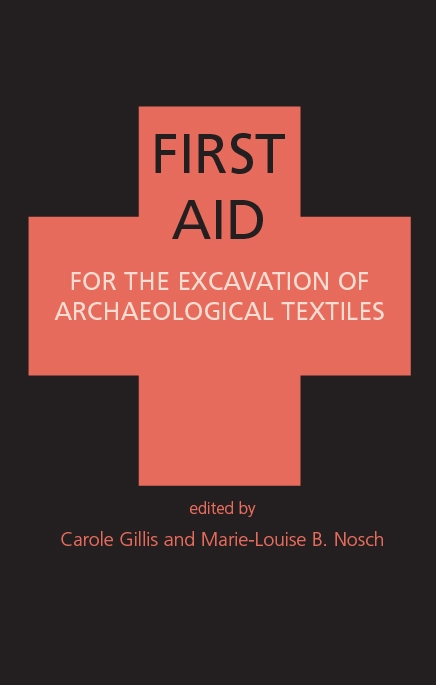List of Contributors
CAROLE GILLIS
Lund University
Department of Archaeology and Ancient History
Box 117
S-221 00 Lund
Sweden
carole.gillis@klass.lu.se
JANA JONES
Macquarie University
2/2A Upper Spit Road
Mosman N.S.W. 2088
Australia
jana2.jones@ozemail.com.au
EVA JORDAN-FAHRBACH
Herzog Anton Ulrich-Museum
Kunstmuseum des Landes Niedersachsen
Museumstrasse 1
D-38100 Braunschweig
Germany
ejf@museum-braunschweig.de
REGINA KNALLER
Rechte Wienzeile 73/1/13,
A-1050 Wien
Austria
Regina.knaller@gmx.at
LOUISE MUMFORD
National Museum and Gallery of Wales
Department of Archaeology and Numismatics
Cathays Park
Cardiff CF10 3NP, Wales
United Kingdom
louise.mumford@nmgw.ac.uk
MARIE-LOUISE B. NOSCH
The Danish National Research Foundations
Centre for Textile Research
The SAXO Institute, University of Copenhagen
Njalsgade 102, DK-2300 Copenhagen S
Denmark
nosch@hum.ku.dk
LISE RDER KNUDSEN
Vejle Country Cultural Heritage Centre
Maribovej 10
DK-7100 Vejle
Denmark
lrk@konservering.vejleamt.dk
ANNEMETTE BRUSELIUS SCHARFF
The Royal Danish Academy of Fine Arts
School of Conservation
Esplanaden 34
DK-1263 Copenhagen K
Denmark
abs@kons.dk
IRENE SKALS
National Museum of Denmark
Brede P.O.Box 260
DK-2800 Kgs. Lyngby
Denmark
JULIE UNRUH
117 Java Street
Brooklyn, NY 11222 USA
julie@unruhly.org
Guidelines for the Excavation of Archaeological Textiles
Jana Jones, Julie Unruh, Regina Knaller, Irene Skals, Lise Raeder-Knudsen, Eva Jordan-Fahrbach, Louise Mumford
Textile finds occur in many different environments under a variety of conditions. Some guidelines are proposed for the following: the excavation process, documentation and storage of excavated material, and collection and storage of samples for scientific analysis. In the absence of an on-site specialist, preventive conservation (provision of optimal conditions to inhibit deterioration and prevent damage) is encouraged.
Introduction
Archaeological textiles are rare finds in some countries and on some sites. Therefore some archaeologists may not recognise them immediately, perhaps are not aware of their importance, and as a result are not always prepared to handle them if they are found. Not only archaeologists, but textile researchers, conservators and chemists deal with various aspects of archaeological textiles. It is of extreme importance that all of these professionals are aware of one anothers activities and can enter into dialogue. It is equally important that these experts discuss the various aspects of excavation, preservation and archiving of archaeological textiles with the organisers when an excavation is being planned, clarifying the costs, needs and responsibilities of all. This can prevent irreversible mistakes and ensure both the preservation and successful outcome of research analysis of the material.
Textile finds benefit from the presence of an on-site textile conservator and specialist. Conservators have knowledge of the chemistry of fibre degradation, can diagnose the state of preservation of textiles, and are trained to handle very fragile objects. They are informed about safe storage materials and have experience in packing objects for transportation. A conservator or textile specialist can identify textile structures that may not be obvious to archaeologists who do not specialise in textiles. Moreover, the quality of conservation treatment is enhanced if the conservator is able to see the object in situ . Ideally, a textile conservator or textile specialist should perform the lifting.
However, it is clear that such an ideal situation is not always feasible, especially on sites where textiles may be chance, unexpected finds. The following guidelines for the textile retrieval, documentation, sampling for future analysis, and proper storage procedures may assist excavators working with textile finds.
Excavation
Textiles survive most frequently in conditions of extreme dryness, permafrost, waterlogged conditions, in contact with corroding metal objects, or in carbonised form within burnt layers. At the moment they are first discovered, archaeological textiles are exposed to enormous danger due to a sudden change in their immediate microclimate. For this reason, changes in any type of climatic conditions must be avoided as much as possible during excavation. Unnecessary movement or touching is also to be avoided.
The excavation process will include a number of considerations, including the following:
- Textiles should always be supported while lifting , with flat supports that can be slid underneath. These can be strong cardboard or wood covered with aluminium foil to prevent contamination, or thin sheets of rigid plastic such as perspex or heavy-gauge Melinex. Larger textile finds can be stabilised and block lifted using plaster or fibreglass bandages to surround and reinforce the block.
- Ideally the whole textile should be lifted with the surrounding matrix , without changing the position of any fragments. It will be easier to identify features such as folds, seams, buttonholes and other details if the exact position of the textile is maintained. Other vital information may also be present in the surrounding soil (see below).
- Textiles from extremely dry environments should be lifted with the surrounding earth where possible. In some cases, the soil or sand supporting a fragile textile may need to be consolidated (impregnated with an adhesive) in order to lift it intact. A consolidant is injected into the soil matrix only at several points around the specimen, so that it can be lifted as a block. The textile itself should not come into contact with the consolidant (see below). A conservator should be consulted about consolidants that are currently recommended, and the suitability of a particular soil consolidant to the specific conditions at the site.
- Frozen textiles should be lifted within a frozen block and kept frozen until treatment in the laboratory. If necessary, they can be kept deep-frozen in situ using carbon dioxide ice. Do not use hot water to rescue frozen textiles.
- In waterlogged environments , wet and dirty textiles can be difficult to recognise, so be attentive. Wet textiles should be block-lifted within a sediment block where possible, and kept wet. Small sediment blocks can be carefully placed into plastic boxes with a layer of polyethylene foam such as Ethafoam on the bottom, stabilised against slipping, and kept wet by keeping the foam damp. Larger textile finds can be stabilised using plaster or fibreglass bandages to reinforce the block. Non-PVC polyethylene cling film should be placed around the block before the application of the plaster or fibreglass to facilitate excavation of the block in the lab without damaging the textiles. Seal the closed boxes or sediment blocks inside plastic bags in order to avoid moisture loss, and keep wet until further excavation in the laboratory.
- Textiles in contact with metal objects are often firmly attached to the corrosion. Do not attempt to separate textiles and metal objects in the field. Examine the surrounding soil carefully, as soil stains or brown shadows can be evidence for the original position of the textile, and can contain textile information. Document the relationship of the artefacts, and lift the textile together with the metal object and the surrounding soil.
- Carbonised textiles are extremely brittle and will break into innumerable components if touched carelessly. Lift with good support and do not attempt to separate them from the surrounding soil.

